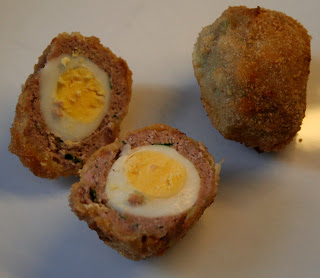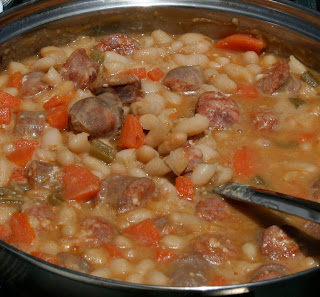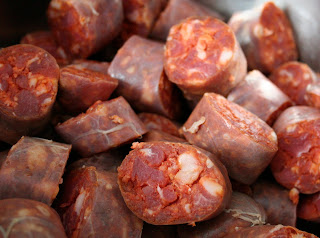One of the fun things about living in another country is that it gives you the opportunity to pass off all kinds of dubious information as hard fact. “Yes, yes. Everyone makes these at home in Scotland. We keep our own quails in the garden specially for this purpose.”

Every year Sammy and Carmela’s school has a multicultural buffet, where parents are meant to bring things from their own country. There are quite a few Moroccan kids in the school, so there is always a good supply of little pastries, and last year there was a great chicken couscous too. There is a girl whose parents are French/Belgian and who have a patisserie, so they bring along a tray of pastries, and this year there was a bit of an Anglo baking competition involving apple pie, brownies and flapjacks.
Anyway, I decided to use the event as an excuse to make Scotch eggs. (Which may not even be Scottish.) They went down surprisingly well, despite a wobbly moment at the beginning, when one of the Moroccan mums bit into one of them and had to be quickly reassured that I had only used beef. (Actually, I wasn’t that surprised, as Spaniards love eggs and mince, and are also pretty keen on anything breaded and fried.)
Making them with quail eggs involves a little more work at the beginning (peeling and coating), but they are easier to fry and much more attractive. Steaming the eggs is important, as it stops them from cracking as they cook and so makes peeling them easier.

This is one of those recipes that I thought would be frustratingly fiddly to do, but it wasn't. For me, there are two kinds of fiddliness in the kitchen: fiddly and difficult (e.g., making baskets out of spun sugar), and fiddly but easy. This one is time-consuming, but it's fairly foolproof and doesn't demand any great technique. So long as I'm in the right mood then I find this kind of thing quite therapeutic.
Ingredients
24 quail eggs
400 g of minced beef
3 spring onions, roughly chopped
fresh parsley
1 teaspoon of mustard
4 teaspoons of grated Parmesan
freshly ground salt and black pepper
3 chicken eggs
flour
breadcrumbs
Method
- Steam the quail eggs for about 5 minutes. Remove, cool in a large bowl of water, and peel.
- Place the mince, spring onions, parsley, mustard, Parmesan, salt and black pepper and ONE of the beaten chicken eggs into the food, and chop until the mixture is quite smooth. (It should start to form a ball.)
- Take a small piece of the mixture, flatten it out in your hand and wrap it round the egg, making sure that the egg is completely covered with a thin layer of meat. (This sounds fiddly, but is actually quite easily. You can just squash it round the egg and pinch off any excess mixture.) Repeat this until all the eggs are covered. (With the quantities above there should be a bit of leftover mixture which can be turned into beefburgers.)
- Put plenty of flour on a plate, plenty of breadcrumbs on another plate, and break the two remaining chicken eggs into a bowl and mix with a fork. One by one, roll the covered eggs in flour, shake off any excess, then pass the floured egg through the egg and then roll it in breadcrumbs. (It’s best to do this in stages: first flour all the eggs, then put them all into the egg mixture, then roll them in breadcrumbs: otherwise you will find that your fingers gradually become covered in a sticky egg and breadcrumb mixture!)
- Fill a large, high-sided saucepan about 2.5 cm deep with sunflower oil. Heat the oil until it is hot but not too hot. (Sorry to be vague, but I don’t use thermometers for this kind of thing.) Place the breaded eggs gently into the oil, fry for a couple of minutes before carefully turning over and frying for another couple of minutes. Remove with a slotted spoon and drain on some kitchen paper.











